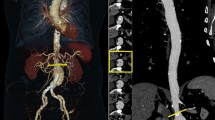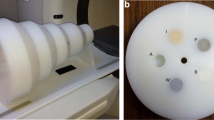Abstract
Background and objective
Decreasing X-ray tube voltage is an effective way to reduce radiation and contrast dose, especially in non-obese patients. The current study focuses on CTA in non-obese patients to evaluate image quality and feasibility of 80-kV acquisition protocols with varying iodine delivery rates (IDR) and contrast concentrations in routine clinical practice.
Methods
A prospective observational study in patients ≥ 18 years and ≤ 90 kg referred for coronary or craniocervical CTA at 10 centers in China (ClinicalTrials.gov: NCT02840903). Patients were divided into four groups: a standard 100-kV protocol (370 mgI/ml, IDR 1.48 gI/s), and three 80-kV protocols (370 mgI/ml, IDR 1.2 gI/s; 300 mgI/ml, IDR 1.2 gI/s; 300 mgI/ml, IDR 0.96gI/s). The primary outcome was contrast opacification of target vascular segments. Secondary outcomes were image quality (contrast-to-noise ratio, signal-to-noise ratio, visual image quality, and diagnostic confidence assessment), radiation, and iodine dose.
Results
From July 2016 to July 2017, 1213 patients were enrolled: 614 coronary and 599 craniocervical CTA. The mean contrast opacification was ≥ 300 HU for 80-kV 1.2 gI/s IDR scanned segments; IDR 0.96 gI/s led to lower opacification. Image quality and diagnostic confidence were fair to excellent (≥ 98% of images), despite lower contrast-to-noise ratios and signal-to-noise ratios in 80-kV images. Compared to the standard protocol, 80-kV protocols led to 44–52% radiation dose reductions (p < 0.001) and 19% iodine dose reductions (p < 0.001).
Conclusion
Eighty-kilovolt 1.2 gI/s IDR protocols can be recommended for coronary and craniocervical CTA in non-obese patients, reducing radiation and iodine dose without compromising image quality.
Key Points
• Using low-voltage scanning CTA protocols, in which tube voltage and iodine delivery rate are reduced proportionally (voltage: 80 kV, IDR: 1.2 gI/s), reduces radiation and contrast dose without compromising image quality in routine clinical practice.
• Reducing iodine delivery rate beyond direct proportionality to tube voltage is not beneficial.



Similar content being viewed by others
Abbreviations
- AB:
-
Coronary CTA segment: branch of atrioventricular node
- ACA:
-
Craniocervical CTA segment: A1 segment of anterior cerebral arteries
- AE:
-
Adverse event
- CCA:
-
Craniocervical CTA segment: common carotid arteries
- CNR:
-
Contrast-to-noise ratio
- CTA:
-
Computed tomography angiography
- CTDIvol:
-
Volume CT dose index
- D1:
-
Coronary CTA segment: first diagonal branch
- D2:
-
Coronary CTA segment: second diagonal branch
- DLP:
-
Dose-length product
- HU:
-
Hounsfield units
- IDR:
-
Iodine delivery rate
- LAD:
-
Coronary CTA segment: proximal left anterior descending artery
- LCX:
-
Coronary CTA segment: proximal left circumflex artery
- LMCA:
-
Coronary CTA segment: left main coronary artery
- MCA:
-
Craniocervical CTA segment: M1 segment of middle cerebral arteries
- PDA:
-
Coronary CTA segment: posterior descending artery
- RCA:
-
Coronary CTA segment: proximal right coronary artery
- ROI:
-
Region of interest
- SNR:
-
Signal-to-noise ratio
References
Bae KT (2010) Intravenous contrast medium administration and scan timing at CT: considerations and approaches. Radiology 256:32–61
Wildberger JE, Mahnken AH, Seidensticker PR (2008) Aorto-peripheral MDCT angiography: implications for contrast medium delivery. Imaging Decisions MRI 11:8–12
Kalisz K, Halliburton S, Abbara S et al (2017) Update on cardiovascular applications of multienergy CT. Radiographics 37:1955–1974
Lubbers MM, Kock M, Niezen A et al (2018) Iodixanol versus iopromide at coronary CT angiography: lumen opacification and effect on heart rhythm-the Randomized IsoCOR Trial. Radiology 286:71–80
Cai W, Hu C, Hu S et al (2018) Feasibility study of iterative model reconstruction combined with low tube voltage, low iodine load, and low iodine delivery rate in craniocervical CT angiography. Clin Radiol 73(217):e211-e217 e216
Chen Y, Zhang X, Xue H et al (2017) Head and neck angiography at 70 kVp with a third-generation dual-source CT system in patients: comparison with 100 kVp. Neuroradiology 59:1071–1081
Fazel R, Krumholz HM, Wang Y et al (2009) Exposure to low-dose ionizing radiation from medical imaging procedures. N Engl J Med 361:849–857
Albrecht MH, Nance JW, Schoepf UJ et al (2018) Diagnostic accuracy of low and high tube voltage coronary CT angiography using an X-ray tube potential-tailored contrast medium injection protocol. Eur Radiol 28:2134–2142
Trattner S, Pearson GDN, Chin C et al (2014) Standardization and optimization of CT protocols to achieve low dose. J Am Coll Radiol 11:271–278
Kalra MK, Sodickson AD, Mayo-Smith WW (2015) CT radiation: key concepts for gentle and wide use. Radiographics 35:1706–1721
Ghekiere O, Salgado R, Buls N et al (2017) Image quality in coronary CT angiography: challenges and technical solutions. Br J Radiol 90:20160567
Alkadhi H, Schindera ST (2011) State of the art low-dose CT angiography of the body. Eur J Radiol 80:36–40
Kok M, Mihl C, Seehofnerova A et al (2015) Automated tube voltage selection for radiation dose reduction in CT angiography using different contrast media concentrations and a constant iodine delivery rate. AJR Am J Roentgenol 205:1332–1338
Mihl C, Kok M, Wildberger JE et al (2015) Coronary CT angiography using low concentrated contrast media injected with high flow rates: feasible in clinical practice. Eur J Radiol 84:2155–2160
Mihl C, Maas M, Turek J et al (2017) Contrast media administration in coronary computed tomography angiography - a systematic review. Rofo 189:312–325
Scholtz JE, Ghoshhajra B (2017) Advances in cardiac CT contrast injection and acquisition protocols. Cardiovasc Diagn Ther 7:439–451
De Cecco CN, Schoepf UJ (2018) New contrast injection strategies for low kV and keV imaging. Appl Radiol 47:7–11
Kok M, Mihl C, Hendriks BM et al (2016) Optimizing contrast media application in coronary CT angiography at lower tube voltage: evaluation in a circulation phantom and sixty patients. Eur J Radiol 85:1068–1074
Wei L, Li S, Gao Q, Liu Y, Ma X (2016) Use of low tube voltage and low contrast agent concentration yields good image quality for aortic CT angiography. Clin Radiol 71(1313):e1315-1313.e1310
Luo S, Zhang LJ, Meinel FG et al (2014) Low tube voltage and low contrast material volume cerebral CT angiography. Eur Radiol 24:1677–1685
May MS, Kramer MR, Eller A et al (2014) Automated tube voltage adaptation in head and neck computed tomography between 120 and 100 kV: effects on image quality and radiation dose. Neuroradiology 56:797–803
Zhang WL, Li M, Zhang B et al (2013) CT angiography of the head-and-neck vessels acquired with low tube voltage, low iodine, and iterative image reconstruction: clinical evaluation of radiation dose and image quality. PLoS One 8: e81486
European Commission (2000) European guidelines on quality criteria for computed tomography, EUR 16262 EN. Luxembourg, Office for official publications of the European Communities. Available via: https://op.europa.eu/en/publication-detail/-/publication/d229c9e1-a967-49de-b169-59ee68605f1a (Accessed July 1st, 2021)
Mortele KJ, Oliva MR, Ondategui S, Ros PR, Silverman SG (2005) Universal use of nonionic iodinated contrast medium for CT: evaluation of safety in a large urban teaching hospital. AJR Am J Roentgenol 184:31–34
Palkowitsch P, Lengsfeld P, Stauch K et al (2012) Safety and diagnostic image quality of iopromide: results of a large non-interventional observational study of European and Asian patients (IMAGE). Acta Radiol 53:179–186
Palkowitsch PK, Bostelmann S, Lengsfeld P (2014) Safety and tolerability of iopromide intravascular use: a pooled analysis of three non-interventional studies in 132,012 patients. Acta Radiol 55:707–714
LaBounty TM, Leipsic J, Poulter R et al (2011) Coronary CT angiography of patients with a normal body mass index using 80 kVp versus 100 kVp: a prospective, multicenter, multivendor randomized trial. AJR Am J Roentgenol 197:W860–W867
Pflederer T, Rudofsky L, Ropers D et al (2009) Image quality in a low radiation exposure protocol for retrospectively ECG-gated coronary CT angiography. AJR Am J Roentgenol 192:1045–1050
Feuchtner GM, Jodocy D, Klauser A et al (2010) Radiation dose reduction by using 100-kV tube voltage in cardiac 64-slice computed tomography: a comparative study. Eur J Radiol 75:e51-56
Zhang C, Zhang Z, Yan Z, Xu L, Yu W, Wang R (2011) 320-row CT coronary angiography: effect of 100-kV tube voltages on image quality, contrast volume, and radiation dose. Int J Cardiovasc Imaging 27:1059–1068
Kayan M, Demirtas H, Türker Y et al (2016) Carotid and cerebral CT angiography using low volume of iodinated contrast material and low tube voltage. Diagn Interv Imaging 97:1173–1179
Mihl C, Wildberger JE, Jurencak T et al (2013) Intravascular enhancement with identical iodine delivery rate using different iodine contrast media in a circulation phantom. Invest Radiol 48:813–818
Kok M, Mihl C, Hendriks BM et al (2016) Patient comfort during contrast media injection in coronary computed tomographic angiography using varying contrast media concentrations and flow rates: results from the EICAR Trial. Invest Radiol 51:810–815
Rengo M, Dharampal A, Lubbers M et al (2019) Impact of iodine concentration and iodine delivery rate on contrast enhancement in coronary CT angiography: a randomized multicenter trial (CT-CON). Eur Radiol 29:6109–6118
Xin WC, Shao XL, Wang YT et al (2018) Is there an incremental value to use myocardial perfusion imaging with or without CT attenuation for the diagnosis of coronary artery disease? A study in Chinese patients. Hell J Nucl Med 21:48–54
Chen Y, Chen R, Zhou X, Liu J, Huang G (2017) Report on the development and application of PET/CT in mainland China. Oncotarget 8:64417–64426
He D, Yu H, Chen Y (2013) Equity in the distribution of CT and MRI in China: a panel analysis. Int J Equity Health 12:39
World Health Organisation (2016) Obesity and overweight. Available via: https://www.who.int/en/news-room/fact-sheets/detail/obesity-and-overweight (Accessed July 1st, 2021)
Acknowledgements
We are grateful to all the patients who participated in the RIGHT study. We thank Dr. Alexander Boreham and Dr. Michael Wördehoff (co.medical, Berlin, Germany) for medical writing support, including work on formatting and polishing tables and charts. We thank Dr. Philipp Lengsfeld and Dr. Peter Seidensticker (Bayer) for the thorough review of the manuscript. We thank Dr. Carsten Schwenke (SCO:SSiS, Berlin, Germany) and Dr. Hanqing Ma (Bayer) for additional statistical analysis during the review process. We also thank investigators in Shantou Central Hospital and the other investigators who participated in the RIGHT study, including Yun Wang, Yumei Li, Hongzhong Mo, Mingdong Chen, Yankui Li, Jing Yu, Zhaocheng Cai, Weiwei Zhao, Zhiwei Han, Caicai Ma, Bei E, Yi Yang, Xiaofeng Wang, Jian Li, Ya Cai, YanWang, Dandan Zhang, Dai ying Lin, Guangzhou Du, Danfeng Wang, Xiangling Zhang, Xiaoyu Li, Yin Yuan, and Xiangshui Meng. We thank the reviewers for their thorough reviews that substantially improved the manuscript.
Funding
This study was sponsored by Bayer AG as a phase IV study.
Author information
Authors and Affiliations
Corresponding author
Ethics declarations
Guarantor
The scientific guarantor of this publication is Prof. Zhengyu Jin.
Conflict of interest
Xiaozheng Yang is an employee of Bayer China. The other authors of this manuscript were the investigators of the study and declare no relationships with other companies whose products or services may be related to the subject matter of the article.
Statistics and biometry
No complex statistical methods were necessary for this paper.
Informed consent
Written informed consent was obtained from all subjects (patients) in this study.
Ethical approval
Institutional review board approval was obtained.
Methodology
• prospective
• observational
• multicenter study
Additional information
Publisher's note
Springer Nature remains neutral with regard to jurisdictional claims in published maps and institutional affiliations.
Authors from all study sites contributed equally to this study.
Supplementary Information
Below is the link to the electronic supplementary material.
Rights and permissions
About this article
Cite this article
Wang, Y., Chen, Y., Liu, P. et al. Clinical effectiveness of contrast medium injection protocols for 80-kV coronary and craniocervical CT angiography—a prospective multicenter observational study. Eur Radiol 32, 3808–3818 (2022). https://doi.org/10.1007/s00330-021-08505-5
Received:
Revised:
Accepted:
Published:
Issue Date:
DOI: https://doi.org/10.1007/s00330-021-08505-5




